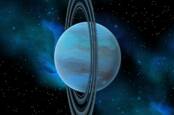This article is more than 1 year old
Scientists stumped by strange X-rays from Uranus
UCL astronomer tells us: 'We were surprised by our discovery'
Mysterious X-rays have been spotted emanating from Uranus for the first time, according to the latest observations made using NASA’s Chandra X-ray Observatory.
X-ray emissions from the planet may not seem so surprising at first since Jupiter, Saturn, Uranus, and Neptune have been found to scatter such radiation from the Sun. But the data suggests that there is an additional source of unknown X-rays being generated by Uranus itself.
“Planets with lots of hydrogen in their atmosphere scatter X-rays in the same way that we think Uranus is [doing],” Affelia Wibisono, co-author of the Uranus X-ray study published in the Journal of Geophysical Research: Space Physics, and a PhD student at University College London, explained to The Register.
“We were surprised by our discovery because we got a lot more X-rays than we should have if Uranus was only scattering the X-rays from the Sun. Almost all of the X-rays we get from Saturn are scattered solar X-rays so there’s something strange going on at Uranus.”
Almost all of the X-rays we get from Saturn are scattered solar X-rays so there’s something strange going on at Uranus
The team was able to estimate how much of the X-ray light coming from the planet came from deflecting sunlight by looking at the Sun’s solar activity and studying Uranus’ atmosphere during observations in 2002 and 2017. They found that although the main source of radiation does indeed come from the Sun, there’s a little extra light coming from somewhere else.
There are two leading ideas as to what might be causing the surplus of X-rays at the moment. It’s possible that Uranus’ faint rings are glowing; nearby charged particles around the planet could be colliding into its icy particles, a process that happens at Saturn, too. Another likelihood is that the skies at Uranus’ are lighting up from aurora events.
The researchers have found other bits of evidence that Uranus might support auroras. “We know that Jupiter and the Earth have X-ray auroras so Uranus might have them too. We timed the Chandra observations to coincide with a solar storm reaching Uranus and we know that the auroras at the Earth, Jupiter and Saturn all brighten during such events. The location of the X-rays seem to lie in exactly the same place as we expect to see the aurora, we just didn’t collect enough X-rays to know if that was actually the case,” Wibisono said.

Look, we've tried, but we just can't write this headline without saying boffins have probed Uranus's cold ring
READ MOREAlthough they spotted light flares on the planet’s surface in 2017, the level of X-rays detected was too low to confirm if they were being emitted by polar lights. The team will need to collect more data using X-ray telescopes like NASA’s Chandra X-ray Observatory or the European Space Agency’s XMM-Newton. It’s difficult to get up close to detect a good signal, considering the planet is almost three billion kilometres away from Earth.
If auroras do exist on Uranus, they’re likely to be quite odd due to the planet’s off-kilter axis of rotation and magnetic field. Other planets in the Solar System rotate and have a magnetic field perpendicular, or nearly so, to their orbit, but Uranus’ is nearly parallel. The strange magnetic field dynamics could help astronomers study X-rays emitted from weirder astronomical objects, Wibisono hoped.
“Neutron stars and black holes can also emit X-rays, so we can apply what we learn about how Uranus produces its X-rays to some of those exotic objects,” she concluded.
"We’re using Juno to understand how Jupiter produces X-rays, so if we have a similar orbiter at Uranus we can do the same thing there. Sending a spacecraft to Jupiter and Uranus is much easier than it would be to send a spacecraft to the nearest neutron stars or black holes, because they’re so much further away from us." ®
